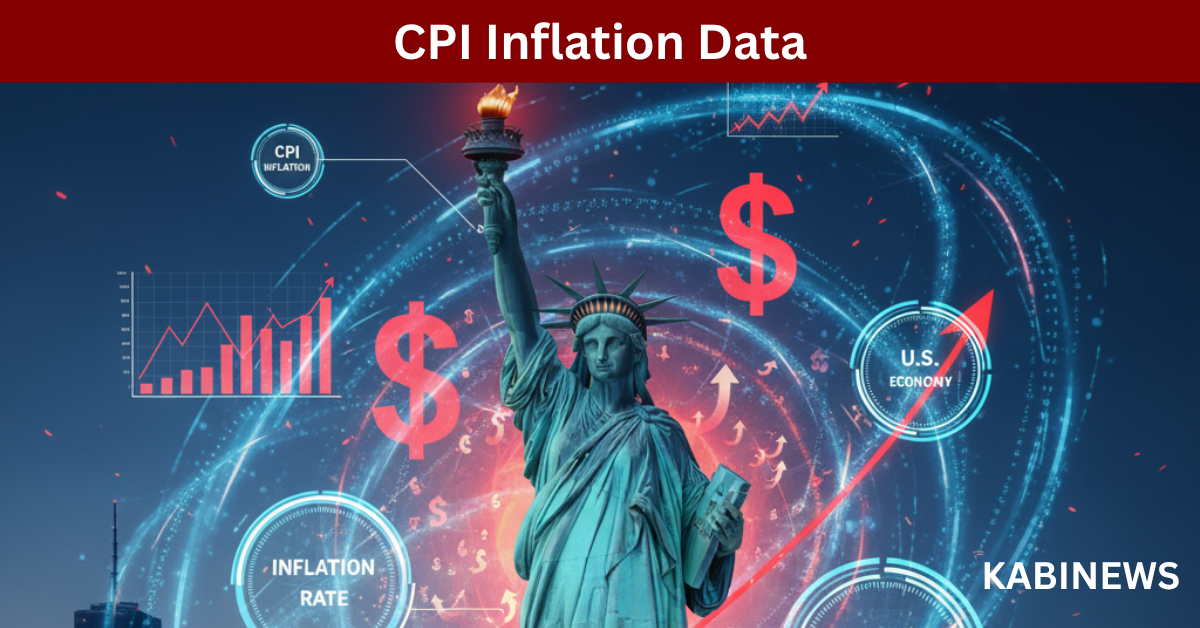Explore the latest U.S. Consumer Price Index (CPI) inflation data, what it means for consumers and businesses, and how to interpret the numbers in 2025.
Introduction
For U.S. consumers, households and businesses alike, inflation isn’t just an abstract economic term—it’s something that affects everyday life. The Consumer Price Index (CPI) is one of the most-widely used gauges of inflation in the United States, and it plays a major role in how economists, policymakers and market participants understand pricing trends. In this blog post, we’ll dive deep into what CPI is, how it’s measured, where we stand today, its implications for you (as a consumer or business operator), and how to interpret CPI data in a way that’s useful for making decisions. The target audience here is U.S.-based readers with interest in business, finance and consumer impacts, so we’ll clarify technical terms, connect with real-life examples, and keep the content AdSense-friendly and SEO-optimized.
What is the CPI and how is it constructed?
The Consumer Price Index (CPI) is published by the Bureau of Labor Statistics (BLS) and measures the average change over time in the prices paid by urban consumers for a “basket” of goods and services. Bureau of Labor Statistics+2Wikipedia+2
Here are key features:
-
Basket of goods and services: Items such as food, housing, apparel, transportation, medical care, recreation, education and communication. Wikipedia+1
-
Coverage: The CPI-U (CPI for All Urban Consumers) covers about 93% of the U.S. population according to BLS definitions. Wikipedia+1
-
Headline vs Core: The “headline” CPI includes all items; the “core” CPI excludes the more volatile food and energy sectors to give a clearer sense of underlying inflation. USAFacts+1
-
Monthly and annual change: The CPI is published monthly and shows both the change from the previous month and the change over the previous 12 months. Bureau of Labor Statistics+1
-
Seasonal adjustment: Some figures are seasonally adjusted to account for predictable seasonal variations (e.g., in energy prices, apparel). Federal Reserve Bank of Minneapolis
Where we are: Recent CPI and inflation data (U.S.)
Let’s look at the latest facts and figures to understand where inflation stands.
-
For the 12 months ending June 2025, the all-items index rose 2.7%. Bureau of Labor Statistics+1
-
In July 2025, the CPI rose 0.2% month-over-month and 2.7% year-over-year. AInvest+1
-
In August 2025, the annual inflation rate accelerated to 2.9%, while core inflation (excluding food & energy) was about 3.1%. Trading Economics+1
-
The latest data from BLS shows for August 2025: CPI-U, All Items rose 0.4% (seasonally adjusted) and 2.9% year-over-year. Bureau of Labor Statistics+1
These numbers indicate that inflation has moderated from its peaks (in earlier years) but is still above the long-term 2% target often referenced by the Federal Reserve and other policy bodies.
Why does CPI matter — and who cares?
For consumers
-
When CPI rises, that means on average you’ll pay more for everyday goods and services — groceries, fuel, rent, utilities, etc.
-
It affects purchasing power: If your wage didn’t rise as fast as inflation, you’re effectively losing ground.
-
It influences cost of living adjustments (COLAs) for things like Social Security benefits, union negotiations, etc.
For businesses & investors
-
Companies use CPI data to adjust pricing strategies, forecast cost pressures, and plan for margins.
-
Investors watch CPI closely because higher inflation may lead to higher interest rates, which can impact stocks, bonds, and other assets.
-
Policymakers use CPI as a key metric for monetary policy decisions — if inflation is too high, the Fed may raise rates; if too low, they may be more accommodative.
For policymakers
-
The Federal Reserve and other institutions use inflation readings (including CPI and related measures) to assess the health of the economy and the risk of inflation spiraling or deflation.
-
CPI data influences interest rate decisions, quantitative easing/tightening strategies, and broader macro-economic policy.
Interpreting the numbers: What to watch and what it means
1. Headline vs Core Inflation
Headline inflation includes everything, but the food and energy components often swing widely month-to-month due to external factors (weather, commodity markets, global supply disruptions). That’s why many analysts focus on core inflation (which excludes food & energy) as a better gauge of underlying price trends. USAFacts
For example, if food and energy prices spike due to a hurricane or global oil shock, headline CPI may jump big, but core CPI might remain more stable. That gives a sense of the inflation that is more likely to persist.
2. Monthly Change vs Year-Over-Year
A monthly increase of, say, 0.3% may look small, but compounded over 12 months that’s about 3.7% (if each month repeated that). The year-over-year number gives the accumulated effect. For example: monthly +0.2% in July 2025 translated to about 2.7% for the year. AInvest+1
3. Inflation expectations & “stickiness”
One of the worries for policymakers is whether inflation becomes “sticky” — meaning it remains elevated despite policy efforts. If people expect inflation to stay high, they may negotiate higher wages, businesses may raise prices pre-emptively, and it can feed a self-reinforcing loop.
4. Comparison to target
The Fed generally has an inflation target of about 2% (for underlying inflation). When CPI or other measures remain consistently above that target, it signals that the economy might be overheating and that interest rates may need to stay higher for longer. For example, the U.S. CPI at ~2.7-2.9% in 2025 remains above 2%. Inflation Calculator+1
What’s driving the recent inflation trends?
-
Housing/Shelter costs: A major component of CPI is shelter (rent + equivalent rent for homeowners). In many cases, even if goods price growth slows, shelter costs remain sticky and keep inflation afloat.
-
Food and Energy: These are volatile. Energy costs can drop fast (good for consumers) or spike with global disruptions. Food supply issues, weather events or supply-chain bottlenecks affect grocery prices.
-
Used vehicles and transportation services: In mid-2025, some categories such as used cars/trucks and transportation services saw faster inflation. Trading Economics+1
-
Global supply chain and tariffs: Import tariffs or supply chain disruptions can ripple into consumer prices. For instance some reports highlighted tariffs possibly contributing to price pressures. Reuters
-
Wages and labor cost pressures: If wage growth accelerates (especially in tight labor markets) businesses may raise prices to maintain margins, feeding inflation.
-
Expectations and policy: If people expect future inflation, actions and pricing-decisions reflect that expectation, making inflation harder to bring down.
What are the implications for you — as a consumer or business?
For consumers
-
Budgeting: If inflation is 2.9% annually, something that cost $100 a year ago now costs about $102.90 (all else equal). That means you’ll need more spending power to maintain the same lifestyle.
-
Savings & investments: Real returns matter. If your savings account yields 1% but inflation is 2.9%, your real purchasing power is falling. You might consider diversifying into inflation-hedged assets or higher-yield investments (bearing risk, of course).
-
Debt decisions: Moderate inflation can erode the real value of fixed interest debt (if your wage growth exceeds the inflation rate). On the flip side, variable-rate loans may become more expensive if interest rates rise.
-
Consumer choice: With inflation, you might substitute cheaper alternatives for items whose prices have risen sharply, or delay big purchases if you expect prices will moderate.
For businesses
-
Cost control & pricing strategy: If your input costs (raw materials, labor) are rising due to inflation, you may need to raise prices, cut costs, or absorb lower margins.
-
Contracting and wage negotiations: In inflationary environments, employees may seek higher wages, and businesses may build inflation clauses into contracts.
-
Inventory & procurement timing: Sometimes companies may pre-buy inventory before expected price increases. But that can lead to over-stocking risks if inflation moderates.
-
Interest rates & financing: Rising inflation often leads to higher rates; businesses with large borrowings must monitor interest-cost risks.
Impact on markets and policy
-
Interest Rates: When inflation remains above expectations, the Federal Reserve may delay cuts or even raise rates to prevent runaway inflation. In contrast, falling inflation can give room for rate cuts. For instance, inflations at ~2.7-2.9% in 2025 are above the Fed’s preferred target. Trading Economics
-
Bond & Equity Markets: Unexpected higher inflation can reduce bond values (since future payments are discounted at higher rates) and may affect equities (especially high-growth stocks). Inflation can also shift sector preferences (e.g., inflation-sensitive sectors vs. value sectors).
-
Dollar and Commodity Prices: Inflation tends to support commodity prices and can influence currency strength.
-
Wage/Price Spiral Risks: Persistent inflation can trigger a spiral where wages and prices chase each other upward, which is harder to break.
What to watch for in upcoming CPI releases
Here are key indicators and data points to keep an eye on:
-
Monthly headline CPI change – low monthly figures ease pressure, higher ones raise concerns.
-
Year-over-year headline and core CPI – especially whether core inflation is accelerating or decelerating.
-
Shelter/Rent component – tends to be sticky and a big driver of CPI.
-
Food and Energy changes – while volatile, they impact consumers directly and sentiment strongly.
-
Producer Price Index (PPI) and other upstream measures – give early signals of cost pressures feeding into CPI.
-
Inflation expectations surveys – if consumers and businesses expect higher inflation, that may feed into actual inflation.
-
Federal Reserve communications – how the Fed interprets CPI data in terms of policy (rate cuts or hikes) matters for markets.
Limitations & caveats of CPI
-
The CPI basket may not match your personal spending pattern exactly — e.g., if you spend more on housing and less on apparel, your “inflation experience” could differ from the headline rate.
-
Quality adjustments: CPI attempts to adjust for improvements in product quality (via hedonic methods), but critics argue this may under-state true inflation in some categories. Wikipedia+1
-
Some argue CPI overstates or understates inflation relative to cost-of-living experienced. For example, the Advisory Commission to Study the Consumer Price Index (‘Boskin Commission’) estimated CPI may have overstated inflation by about 1.1 percentage points in earlier years. Wikipedia
-
The CPI focuses on consumer goods and services, and may not fully capture asset-price inflation (housing price gains, stock market gains) which affect wealth though not necessarily direct consumer spending.
-
Regional variations: Inflation in one city or state may differ from the national average due to local housing/energy cost differences.
Practical take-aways and tips
-
If you’re a consumer: Review your budget and check if your income or savings interest is keeping up with inflation (~2.7‐2.9% in 2025). Consider diversifying savings or investing in inflation-protected assets (e.g., TIPS, real assets) depending on your risk profile.
-
If you’re a business: Monitor your input cost trends (especially labor, shelter/rent, and energy); evaluate whether your pricing strategy needs adjustment; consider the timing of contracts and procurement.
-
For both: Keep an eye on upcoming CPI releases (typically around mid-month). A higher surprise in CPI may lead to higher interest rates or cost pressures; a lower surprise may signal easing inflation.
-
Maintain clarity: Don’t overreact to single month spikes or drops—look at trends over quarters or years.
-
Stay informed: Understand whether the inflation you’re seeing is “transitory” (short-lived) or likely to persist (structural causes). That helps determine whether you should adjust decisions.
Conclusion
The Consumer Price Index is more than just a number reported monthly—it’s a vital tool for understanding how prices for everyday goods and services are changing in the U.S. economy. With annual inflation around 2.7-2.9% in 2025 and core inflation at about 3.1%, the data indicate moderate but not negligible price pressures. As a consumer, business, or market participant, knowing how to interpret CPI helps you make smarter decisions about budgeting, pricing, investments and policy expectations.
Inflation isn’t the same across all items or regions, and while the CPI gives a broad national picture, your personal experience may differ. The key is to stay alert to trends, understand the underlying drivers, and plan accordingly.
Key take-away: Inflation at ~3% means your dollar buys about 3% less than it would have a year ago (all else equal). If your income or returns don’t keep pace, you risk losing purchasing power. Likewise, businesses that ignore inflation may see margin erosion or cost shocks. Use CPI as a compass—not as the whole map—and prepare accordingly.







